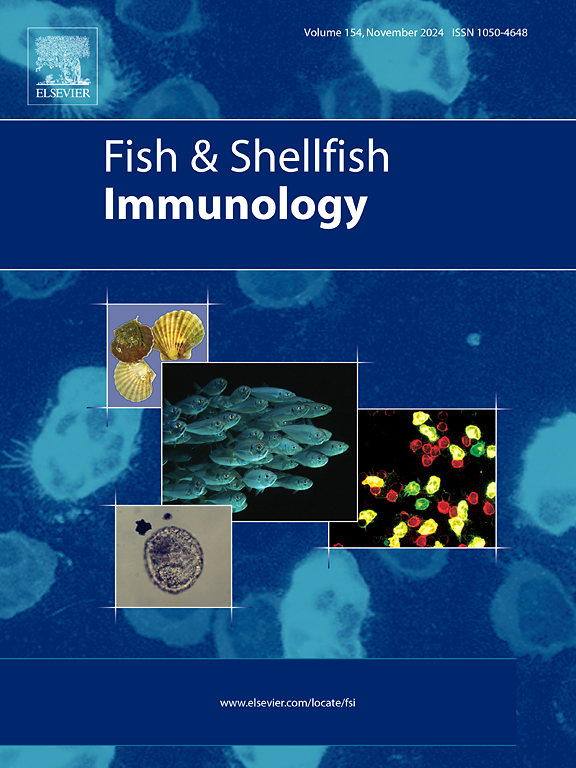通过PI3K/Akt信号通路调节低氧和热暴露诱导的氧化状态、免疫和细胞凋亡的机制
IF 4.1
2区 农林科学
Q1 FISHERIES
引用次数: 0
摘要
大鳞鲃是中国一种主要的草食性鱼类,具有显著的经济效益,但由于全球变暖和集约化养殖等因素导致的缺氧和高温,其生存和生长经常面临严峻挑战。为了评估这些应激因素的综合影响,我们进行了双因素交叉试验,以评估同时暴露于缺氧(2 mg/L)和高温(35 °C)对伏鱼氧化应激、免疫和细胞凋亡的影响。结果表明,缺氧和受热显著增强了氧感应基因和热休克蛋白(HSP)基因、缺氧诱导因子1α(Hif-1α)、HIF-脯氨酰羟化酶-2(phd2)和抑制Hif-1的因子(fih-1)以及hsp70和hsp90α的表达。此外,缺氧和热暴露下的伏走蝇肝脏组织会发生多种变化,其中同时暴露于缺氧和热暴露下的伏走蝇肝脏组织病变最严重,丙氨酸氨基转移酶(ALT)和天冬氨酸氨基转移酶(AST)上调。此外,缺氧和高温联合暴露最初会导致总抗氧化能力(T-AOC)、超氧化物歧化酶(SOD)和过氧化氢酶(CAT)的活性以及谷胱甘肽(GSH)含量增加,随后降低,丙二醛(MDA)积累,从而诱发氧化应激。与此同时,碱性磷酸酶(AKP)、酸性磷酸酶(ACP)、补体成分 3(C3)和 C4、免疫球蛋白 M(IgM)和干扰素-γ(IFN-γ)的含量先增加后减少,导致免疫抑制。此外,缺氧和热暴露会上调抗氧化酶基因(nrf2、cu/zn-sod、mn-sod cat、ho-1、pi3k 和 gpx-1a)、炎症基因(白细胞介素 il-1β、il-8 和 tnf-α)、免疫效应因子(igm 和 lyz)以及凋亡基因的表达、以及凋亡基因(casp3、casp8、casp9 和 p53)和活化的 p-Akt/Akt,这表明细胞凋亡可能与氧化应激和炎症有关,并通过 PI3K/Akt 信号通路介导。总之,缺氧和高温的联合暴露破坏了伏季休渔鱼的体内平衡,其有害影响比单独暴露于其中一种胁迫更明显。这些结果将有助于了解鱼类联合暴露于缺氧和高温的机制,并为渔业管理提供基础。本文章由计算机程序翻译,如有差异,请以英文原文为准。
Regulation mechanism of oxidative status, immunity and apoptosis induced by hypoxia and heat exposure via PI3K/Akt signaling pathway in Megalobrama amblycephala
Megalobrama amblycephala, a main herbivorous fish with notable economic benefits in China, often faces serious challenges to its survival and growth due to hypoxia and heat caused by factors such as global warming and intensive aquaculture. To evaluate the combined effects of these stressors, we performed a two-factor crossover test to assess the impacts of simultaneous exposure to hypoxia (2 mg/L) and heat (35 °C) on oxidative stress, immunity and apoptosis in M. amblycephala. These results showed that hypoxia and heat exposure significantly enhanced the expression of oxygen-sensing and heat shock protein (HSP) genes, hypoxia inducible factor 1α (Hif-1α), HIF-prolyl hydroxylase-2 (phd2) and factor inhibiting Hif-1 (fih-1), as well as hsp70 and hsp90α. Furthermore, M. amblycephala suffering from hypoxia and heat exposure exhibited several changes in liver tissues, with the most severe lesions and up-regulation of alanine aminotransferase (ALT) and aspartate aminotransferase (AST) observed in those subjected to simultaneous exposure. Moreover, the combined hypoxia and heat exposure initially triggered an increase in the activities of total antioxidant capacity (T-AOC), superoxide dismutase (SOD) and catalase (CAT), and glutathione (GSH) contents, followed by a reduction, and the accumulation of malondialdehyde (MDA), which induced oxidative stress. This was accompanied by an increase and subsequent reduction in the contents of alkaline phosphatase (AKP), acid phosphatase (ACP), complement component 3 (C3) and C4, immunoglobulin M (IgM), and interferon-γ (IFN-γ) leading to immunosuppression. Additionally, hypoxia and heat exposure up-regulated the expression of antioxidant enzyme genes (nrf2, cu/zn-sod, mn-sod cat, ho-1, pi3k and gpx-1a), inflammatory genes (interleukin il-1β, il-8 and tnf-α), immunity effectors (igm and lyz), as well as apoptosis genes (casp3, casp8, casp9 and p53) and activated p-Akt/Akt, suggesting apoptosis may be linked with oxidative stress and inflammation and mediated through the PI3K/Akt signaling pathway. In short, the combined hypoxia and heat exposure disrupted homoeostasis in M. amblycephala, with a more pronounced detrimental effect than exposure to either stressor alone These results will contribute to understanding the mechanism of combined exposure to hypoxia and heat in fish and provide a fundamental base for fisheries management.
求助全文
通过发布文献求助,成功后即可免费获取论文全文。
去求助
来源期刊

Fish & shellfish immunology
农林科学-海洋与淡水生物学
CiteScore
7.50
自引率
19.10%
发文量
750
审稿时长
68 days
期刊介绍:
Fish and Shellfish Immunology rapidly publishes high-quality, peer-refereed contributions in the expanding fields of fish and shellfish immunology. It presents studies on the basic mechanisms of both the specific and non-specific defense systems, the cells, tissues, and humoral factors involved, their dependence on environmental and intrinsic factors, response to pathogens, response to vaccination, and applied studies on the development of specific vaccines for use in the aquaculture industry.
 求助内容:
求助内容: 应助结果提醒方式:
应助结果提醒方式:


